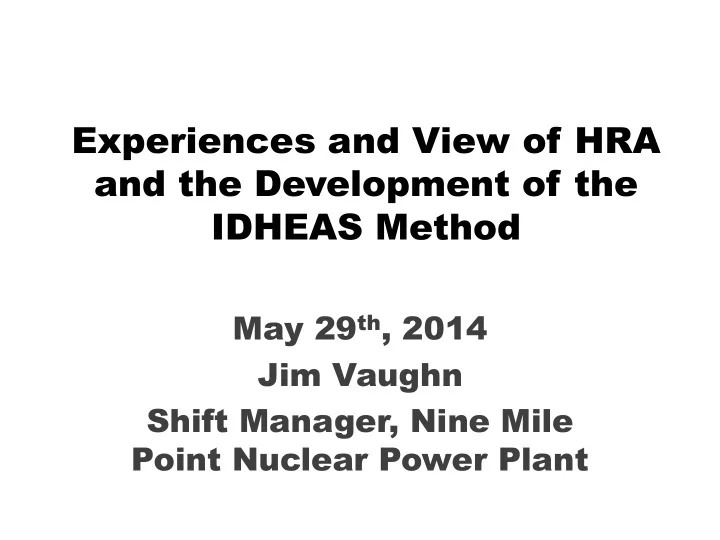

Experiences and View of HRA and the Development of the IDHEAS Method May 29 th , 2014 Jim Vaughn Shift Manager, Nine Mile Point Nuclear Power Plant
Operations Background • S8G Naval Training Prototype (2000-2007) – Engineering Officer of the Watch, Shift Supervisor • Nine Mile Point (NMP) – Licensed Senior Reactor Operator (2009-present) – Shift Manager (2013-present) 2
HRA Background • Revised Operator Actions for NMP PRA model (2010) • Supported TS Amendment Change by modeling new Operator Action (2011) • NFPA 805 PRA Review (2011-present) • Participated in IDHEAS Expert Elicitation panel (2013) • Operations SME in Significance Determination Process (SDP) Response for NMP Loss of Shutdown Cooling (2013) 3
HRA Experience • Reviewed Operator Actions for NMP PRA Model – Revised all Internal Events actions – Based on that review, identified improvement opportunities, such as: • Identified Emergency Operating Procedure (EOP) enhancements on containment venting strategy • Identified enhancements to training program based on review of top operator actions • Processed additional procedure changes to reduce human error probability 4
Perspective on HRA • Operator engagement in HRA is critical – A strong alignment with Operations is necessary to ensure accurate HRA modeling – It is important that HRA results include the ‘common sense’ perspective of those who have performed the task before in the field, or during transients, or during simulator training sessions • That is, does the modeling reflect actual challenges and error traps encountered? 5
Perspective on HRA • Most Importantly… – The exercise of soundly applying HRA methodology to key operator actions should have the net effect of identifying and mitigating barriers standing in the way of successful completion of those actions. – Procedures, Training, Design Assumptions, Work Practices, and Operator Proficiency must all be evaluated for weaknesses when applying HRA. 6
IDHEAS Experience • Solicited Input from Operations Community – Participated in Expert Elicitation Panel with two Operations Training Instructors from various plants – Participated in two one week long workshops to review IDHEAS concept 7
IDHEAS Experience – Reviewed proposed Crew Failure Modes, Performance Influencing Factors, Cognitive Mechanisms, and Crew Response Trees – Discussed real world operations experience for the realistic application of Crew Failure Modes – Provided weighting to the Performance Influencing Factors – Eliminated branches of Crew Response Trees which would not be applicable 8
Perspective on IDHEAS • Good Start – Comparison of Performance Influencing Factors of IDHEAS vs. THERP , SPAR-H and other existing methods indicates that a better model of HRA is on the horizon – From an Operations perspective, a key advantage of IDHEAS is that it addresses an integrated crew response compared to focus on individual error drivers 9
Perspective on IDHEAS • However… – A continuous tie to the Operations community needs to be maintained going forward – Comparison of IDHEAS results to existing HRA models and to actual known performance should be the litmus test of whether or not IDHEAS will drive improvement or provide just another alternative methodology – For example…… 10
Perspective on IDHEAS • Torpedo in the water… All Ahead Flank Cavitate! – SPAR-H: 2.5E- 4 (with “nominal training”) compared to 1.5E- 3 (with “low” training) – IDHEAS: Not all Nodes quantified yet – Actual Training Results: Not quantified by any known studies, but low or no training results in a Very Low success rate; after extensive training and practice – Very high success rate. • We need to compare whichever HRA methodology we choose to real world applications to ensure the results are reasonable. 11
Final Thought on HRA • How do we test our hypothesis that a particular method is reasonable? – That is, do we have a litmus test to know if the results are meaningful? – Examples: • Apply scenarios such as the throtttleman answering a cavitate bell to the method and see if the answers make pragmatic sense • Observe a simulated scenario which follows a given accident sequence. Identify ‘pinch’ points in the evolution which could lead to team failure and compare to modeled failure modes 12
Operations Perspective • Questions? 13
Recommend
More recommend